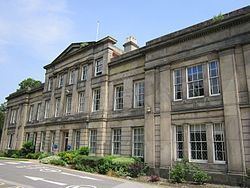Type College Built 1775 & 1843 Governing body Privately owned | Location Didsbury, Manchester Architectural style(s) Neoclassical Designated 25 February 1952 | |
 | ||
Similar Estate Exchange, Store Street Aqueduct, Church of St Michael and All A, Smithfield Market Hall, Odeon Cinema - Manchester | ||
The Didsbury School of Education, Wilmslow Road, Didsbury, Manchester, England, is a former campus of Manchester Metropolitan University. It was originally built as a private house around 1785, and became a theological college for the Wesleyan Methodist Church in 1843. The main college building was designated a Grade II* listed building on 25 February 1952.
Contents
The site is currently undergoing redevelopment as a residential area.
History
The 10-acre (40,000 m2) site was purchased by the Wesleyan Methodist Church in 1840, with the intention of founding a theological college as part of their centenary celebrations, an initiative started ten years previously by the Methodist scholar Adam Clarke. The new site at Didsbury was selected to replace temporary training facilities at Hoxton Square and Stoke Newington in London. Another Wesleyan college was founded at around the same time in Richmond, Surrey.
A "handsome house of circa 1785" already stood on the Didsbury site, which had once been the residence of a Colonel Parker. The Methodist owners extended the house and constructed new buildings on the site to house lecture halls, classrooms, a library and accommodation for students and tutors, as well as a brick chapel building. The Wesleyan Theological Institute opened on 22 September 1842 with a special service. By the end of the nineteenth century, the Didsbury and Richmond Colleges had become branches of a national Wesleyan Theological Institution, along with Wesley College, Headingley in Leeds and Handsworth College in Birmingham. The first president of the Institute was Jabez Bunting, and John Hannah was among the first tutors. Science lecturers who taught at the college included William Sturgeon and William Crawford Williamson.
In 1877, a new church was built to serve the college, the large Victorian Gothic St Paul's Methodist Church, on the adjacent site.
After the Methodist Union of 1932 it was not the only Methodist college of its type in Manchester; during World War II the site was used as a military hospital and after the war the church closed it and sold the site. The Methodist Church transferred the facilities to Didsbury College, Bristol in 1946.
The Manchester site re-opened as the Didsbury School of Education, and became part of Manchester Polytechnic in 1977. Manchester Metropolitan University used the site as its education college until 2014, when it vacated the Didsbury campus and Broomhurst Halls of Residence and relocated to a new campus at Birley Fields. The site is currently (February 2017) being redeveloped as a residential area, with the listed buildings being retained.
Noted alumni of the Wesleyan College
Archives for the former Wesleyan College are held today at the Methodist Archives and Research Centre at the John Rylands Library in Manchester.
Architecture
The original red brick house which stood on the site was extended and re-clad in ashlar stone in a Neo-Grecian style by the Wesleyans.
The substantial Grecian frame comprises eleven bays and four pilasters decorated with carved lotus leaf capitals and acanthus bases, probably by the architect Richard Lane. Pevsner suggests that these architectural details were taken from illustrations by James Stuart and Nicholas Revett of the Ancient Greek Tower of the Winds in Athens, and notes that identical decorations can be seen on another house by Lane at 84 Plymouth Grove in Manchester, later occupied by Elizabeth Gaskell. The building has "sandstone ashlar facades, with rear and courtyard walls of red brick in Flemish bond with sandstone dressings". The original brick house can still be seen today from the courtyard at the back of the college.
The interior contains a fine "entrance hall with [a] screen of reeded columns [and an] elliptical open-well staircase with wrought-iron balustrade".
